
The Digital IXUS is a series of digital cameras released by Canon. It is a line of ultracompact cameras, originally based on the design of Canon's IXUS/IXY/ELPH line of APS cameras.

Canon EOS is an autofocus single-lens reflex camera (SLR) and mirrorless camera series produced by Canon Inc. Introduced in 1987 with the Canon EOS 650, all EOS cameras used 35 mm film until October 1996 when the EOS IX was released using the new and short-lived APS film. In 2000, the D30 was announced, as the first digital SLR designed and produced entirely by Canon. Since 2005, all newly announced EOS cameras have used digital image sensors rather than film. The EOS line is still in production as Canon's current digital SLR (DSLR) range, and, with the 2012 introduction of the Canon EOS M, Canon's mirrorless interchangeable-lens camera (MILC) system. In 2018 the system was further extended with the introduction of the EOS R camera, Canon's first full frame mirrorless interchangeable lens system.

A digital single-lens reflex camera is a digital camera that combines the optics and the mechanisms of a single-lens reflex camera with a solid-state image sensor and digitally records the images from the sensor.
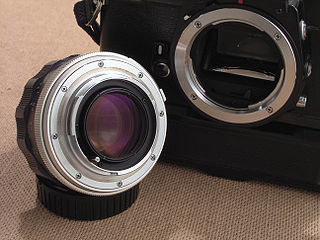
A lens mount is an interface – mechanical and often also electrical – between a photographic camera body and a lens. It is a feature of camera systems where the body allows interchangeable lenses, most usually the rangefinder camera, single lens reflex type, single lens mirrorless type or any movie camera of 16 mm or higher gauge. Lens mounts are also used to connect optical components in instrumentation that may not involve a camera, such as the modular components used in optical laboratory prototyping which join via C-mount or T-mount elements.

The Canon PowerShot G is a series of digital cameras introduced by Canon in its PowerShot line in 2000. The G series cameras are Canon's flagship compact models aimed at photography enthusiasts desiring more flexibility than a point-and-shoot without the bulk of a digital single-lens reflex camera.

Advanced Photo System type-C (APS-C) is an image sensor format approximately equivalent in size to the Advanced Photo System film negative in its C ("Classic") format, of 25.1×16.7 mm, an aspect ratio of 3:2 and Ø 31.15 mm field diameter. It is therefore also equivalent in size to the Super 35 motion picture film format, which has the dimensions of 24.89 mm × 18.66 mm and Ø 31.11 mm field diameter.

The Canon EOS 5D is a 12.7 megapixel digital single-lens reflex (DSLR) camera body produced by Canon. The EOS 5D was announced by Canon on 22 August 2005, and at the time was priced above the EOS 20D but below the EOS-1D Mark II and EOS-1Ds Mark II in Canon's EOS digital SLR series. The camera accepts EF lens mount lenses.
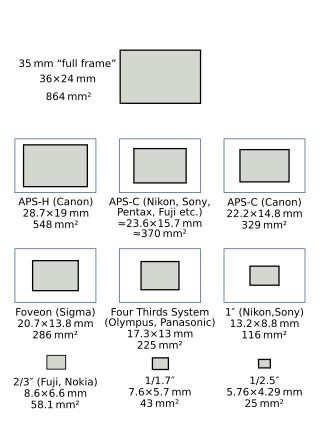
A full-frame DSLR is a digital single-lens reflex camera (DSLR) with a 35 mm image sensor format. Historically, 35 mm was one of the standard film formats, alongside larger ones, such as medium format and large format. The full-frame DSLR is in contrast to full-frame mirrorless interchangeable-lens cameras, and DSLR and mirrorless cameras with smaller sensors, much smaller than a full 35 mm frame. Many digital cameras, both compact and SLR models, use a smaller-than-35 mm frame as it is easier and cheaper to manufacture imaging sensors at a smaller size. Historically, the earliest digital SLR models, such as the Nikon NASA F4 or Kodak DCS 100, also used a smaller sensor.

Digital Imaging Integrated Circuit is Canon Inc.'s name for a family of signal processing and control units for digital cameras and camcorders. DIGIC units are used as image processors by Canon in its own digital imaging products. Several generations of DIGICs exist, and are distinguished by a version number suffix.

The Canon EOS 5D Mark II is a 21.0 effective megapixel full-frame CMOS digital single-lens reflex camera made by Canon, the first Canon EOS camera to have video recording capabilities. It succeeds the EOS 5D and was announced on 17 September 2008.
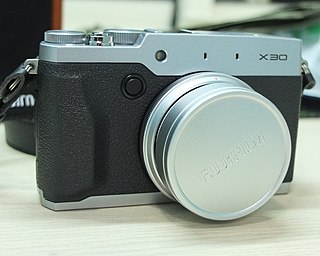
The Fujifilm X30 is an advanced digital compact camera announced by Fujifilm on August 26, 2014. It succeeds the Fujifilm X20 whose 12 megapixel X-Trans CMOS sensor it shares. The X30 abolishes the tunnel optical viewfinder of the X20 and offers an electronic viewfinder instead. In terms of more advanced compact cameras, it occupies the middle ground between the Canon PowerShot G16 and Nikon Coolpix P7800 on the one hand, and Sony RX100 series and Canon PowerShot G1 X series on the other. In terms of Fujifilm's own product line, it is positioned as a more compact and affordable model than the Fujifilm X100S, which has a larger APS-C sized sensor that records 16 megapixels.

The Canon PowerShot G1 X is a large sensor digital compact camera announced by Canon on January 9, 2012.
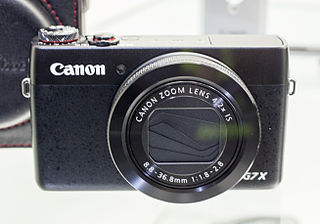
The Canon PowerShot G7 X is a compact digital camera announced by Canon Inc. on September 15, 2014. It did not replace any model in the Canon lineup. Instead, it was a new camera intended to compete with the Sony Cyber-shot DSC-RX100-series cameras. With the introduction of G7 X, there were three parallel models in the Canon PowerShot G-series: G16, G1 X Mark II, and G7 X.
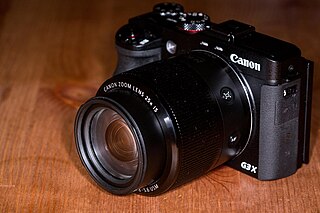
The Canon PowerShot G3 X is a large sensor digital bridge camera announced by Canon on June 18, 2015. It marks Canon's entry into this product category, alongside competitors such as the Panasonic Lumix DMC-FZ1000, Sony Cyber-shot RX10 and RX10 II.
The Canon PowerShot G9 X is a digital compact camera announced by Canon Inc. on October 13, 2015. The G9 X replaces the older Canon PowerShot S120 compact camera. With a reduced zoom range and larger sensor, the camera was the smallest and lightest compact camera since the Canon PowerShot G7 X.
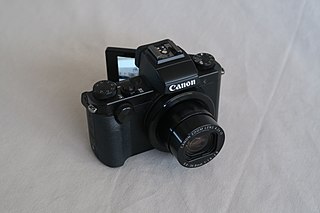
The Canon PowerShot G5 X is a compact digital camera announced by Canon Inc. on October 13, 2015. It replaced the older G16.

PowerShot G9 X Mark II was released by Canon in February 2017. It kept the small size of previous PowerShot models, making it 3 grams lighter than its predecessor. It replaced the Digic 6 processor with a Digic 7 processor, making the camera operations faster. It features a 1.0-inch, 20.1 Megapixel CMOS sensor. The camera is in the Canon PowerShot G series.
















